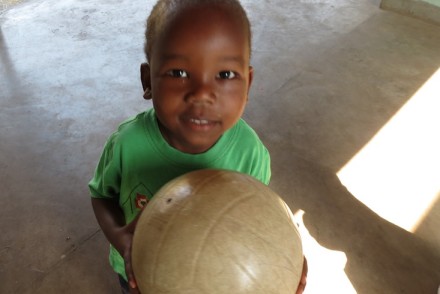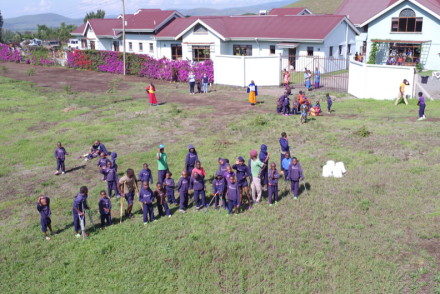The first sentence for this essay that came to mind as I sat entranced under jacaranda trees last Saturday night, was, “There are no words to describe this and sadly because I am not a professional or even an avid photographer, I do not have my camera with me. How could I possibly describe these sights, these sounds, these feelings?”
Hmm. I guess I could simply begin by describing the scene in which I felt truly part of by our new Arusha home.
Alex, Anna, Layla and I along with our new family from Kimemo, Sas (a sobriquet for Sarah) and her sister Denise have arrived at the Ibuka Dance theatre atop Themi Hill, south of Arusha. We stand at the top row of an amphitheatre. My eyes scan the scene and I am caught completely off guard by Mt. Meru hazy in the last of the evening sun dwarfing the stage roof. My eyes move overhead to a half moon directly above. Wow, I say to Anna, look at that, gesturing to the mountain. She takes my hand and encourages me down the stairs about midway to a row of cushioned benches.
I am a bit stunned. When Sas invited us to accompany her and Denise to Ibuka’s performance she described Ibuka as a labor of love of an American girl whom Sas wanted to support. I had envisioned a small, unprofessional indoor dance studio. I certainly should have known better, at least about the indoor part. Everything here in North-Eastern Tanzania is outside, schools, businesses, restaurants. Why not a dance studio?
Alex disappears and then reappears with wine and beer for all of us and a Tangawizi for Layla and a Sprite for Anna. A Tangawizi is local ginger beer that Layla loves. Dark has fallen and the lights come up on stage. Ozzie, the m.c. for the evening introduces himself. He is twenty-something, thin with dreads and wearing white pants and a white shirt. His voice is mellifluous and the audience quiets. He explains that after many postponements we are all here for the grand opening performance of Ibuka Dance. He introduces Anna Bussey, founder of Ibuka (which means Rising). Anna, probably also in her twenties, comes out onto the stage. She has long brown hair and wears a short dress of African fabric, very high heels which show off her dancers’ calves and speaks with an indefinable accent.
It’s showtime! First up are Ozzie and his partner salsa dancing — flawless. Next a group of boys and girls from the St. Constantine International School perform a dance wearing tall gumboots. The dance represents South African miners communicating through their feet because they were not permitted to speak aloud to one another.
And the last dance of the first act is a dance company from Kenya. Four men and four women topless except for black sports bras wear brown flowing pants and skirts with a wide bright green, yellow and orange waste band. The dance is themed “hands” because as Ozzie explains hand gestures often mean different things to different cultures so we are to watch the dancers’ hands. The dance has multiple movements with different music, both African and western. I do not readily grasp the “hands” theme. What I am readily enraptured by is the exquisite beauty in motion, the athleticism of the dance and the precision of the dancers. Tears fill my eyes — Africans dancing under the roof of Mt. Meru and our Earth’s moon, sitting with my family in air that is imperceptible against my skin. All feels right in my world.
And then an atavistic part of my brain awakens and I see before me African tribesmen and women running, hiding, crying. Muscular and determined Africans running from white men and their co-conspirators who are attempting to round them up and rip them from their homes, families, children to put them on ships to the New World. The evanescent vision fades. The beauty before me and the oneness of the audience, an audience of white and black Tanzanians and foreigners from every corner of the world celebrating the Kenyan dancers reemerge.
Intermission.
How could Act II ever match up with the Act I? Ozzie and Anna Bussey introduce the dance “Vertical Mattress.” Anna choreographed this dance and won second place in Italy. Two toe bars are brought on to the stage. A mattress sits to the far right. Two dancers dressed in street clothes enter from the left. The dancers mimic frenetic daily life. The woman moving with precision but with the grace of a professional dancer hangs up the laundry, makes her husband a cup of coffee, dresses for work. The man’s movements compliment the woman’s. At the end of the workday, it’s time for bed. The dancers toss and turn, flip and flop on the throughout the night. The choreography and dancers are worthy of the best dance companies in the United States. The audience rises to their feet cheering and shouting “bravo!” We file out, completely stunned. Denise just says, wow, wow, wow, over and over again. The sense that we have all been part of something new and important to East Africa is palpable.
And just when we thought the evening couldn’t be a smidgen better we were off to Khan’s Chicken-on-the-Bonnet. Would it be open at 10:45 at night, Sas wondered aloud — while I wondered silently, what is Chicken-on-the-Bonnet anyway? We drive from south of the city to downtown, near the intersection of Mosque and Somali streets. It’s dark. Every business is shuttered. I know this will be hard to believe but the streets are immaculate, not a single piece of garbage on the sidewalks or in the gutters. Up ahead on the left we see people gathered and kettle-drum grills with red-skinned chickens simmering above glowing coals. This is Khan’s and we park across the narrow street. We jump out of the car. Layla turtles through from the way back to the back seat trying to catch up. Our noses delight as we scamper like bears to honey to get a closer look at the grills. Sas and Denise both give Khan a big hug hello and we take a picnic table seat. Khan runs the auto parts store behind the grills by day and by night — he’s mister Chicken-on-the-Bonnet. (Bonnet is the word for the hood of a car in British English.) Sas points us to a tank of water set up for hand washing. The water is hot and there is soap and a towel. Really, how does he pull that off?
We make plates of the salads he is offering tonight; cabbage, fig-size aubergines, lentils, and more that I was not able to identify. And then Khan places two large plates of the red-spiced, grilled chicken cut into recognizable parts in front of us. Next, he sets down a tower of naan. It is all chow-down fabulous, scrumptious! We eat and eat and eat. We are giggling and happy and feeling so loved by Sas and Denise and now by Khan. I am starting to understand that what I have found here in Arusha are two of my favorite cultures all in one place – Tanzanian and Indian. I am smitten.
We don’t want the evening to end. But now it is close to midnight. None of us, except maybe Layla, is feeling tired.
Loving this life right now.
BTW, no stomach problems from the chicken-on-the-bonnet!
Visit https://www.facebook.com/ibukadancefoundation for more information and photos of the evening. Watch out for their Crowdfunding campaign which involves you making a dance video!





Exquisite. (I’ll have to keep finding new adjectives to describe your delicious stories!)
Fantastic! Sobriquet and atavistic…. you use these words. Keep writing and living. Eileen
I love living in a world that has Chicken on the Bonnet.
Love my Vocabulary Builder on my Kindle!!
Gettlebys we miss you. Happy Birthday Gail! Much aloha and Jambo Jambo!